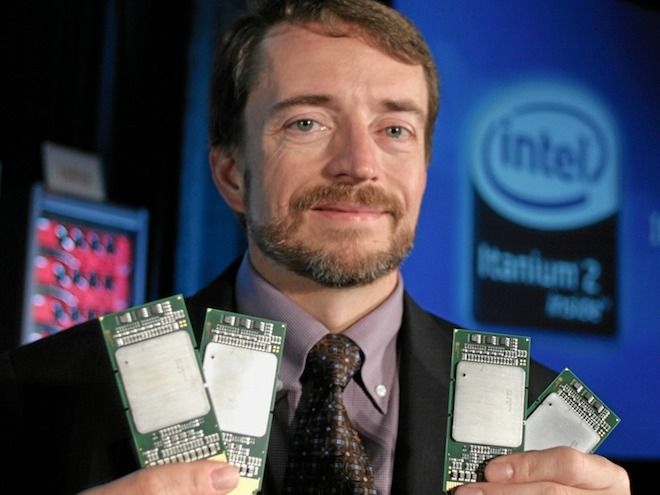Intel Appoints Pat Gelsinger as New CEO, From Feb 15th
by Dr. Ian Cutress on January 13, 2021 9:41 AM EST
News is breaking that Intel has announced that Pat Gelsinger, CEO of VMWare, is to take the role of CEO at Intel from February 15th.
Intel today has released a press statement saying that current CEO Bob Swan (who we interviewed only a few days ago!) is to step down in his role, and be succeeded by Pat Gelsinger. Gelsinger, a veteran of the industry, has spent over 40 years at companies such as VMWare, EMC, and spent 30 years previously at Intel, reaching the potisition of Chief Technology Officer. In that role he drove creation of standards such as USB, Wi-Fi, he was the architect of the 80486, and played key roles in 14 generations of Intel Core and Xeon processors. As CEO of VMWare since 2012, Pat has overseen a tripling of annualized revenue to make VMWare a recognized global leader in global infrastructure and cyber security.
Rumors of Intel getting a new CEO have never died down, even since Bob Swan officially took the role from Brian Krzanich in January 2019. Through those two years, Swan has seen successive YoY growth in the companies revenue streams, as well as a turnover of high-profile technical personnel, such as Dr. Murthy Renduchintala. The goal has seemingly been to push Intel into more areas for TAM growth, while at the same time push through the fundamental issues surrounding the delays to manufacturing on the 10nm node, which has been delayed for a couple of years at this point, and the 7nm node, to which delays were announced more recently. The missing piece of the puzzle has been having an engineer at the top of Intel's food chain, particularly one well versed in Intel's product portfolio, and for those that wanted this to happen, it appears to be so, from February 15th.
Bob Swan will still head the Intel financial call on January 21st, where the company is set to announce how it will approach its future process node strategy, namely 7nm, in light of recent delays. This call should indicate how much Intel is set to invest in its own manufacturing facilities, and how much it may offload to third party foundries during that timeframe. During our interview with Bob Swan, he mentioned that Intel would only work with third party foundries if it could get preferential treatment for the volumes it needed, as well as integration with all related design tools. Swan also stated that licensing a process node technology from someone else for use in Intel's fabs was also an option the company could be considering. No word has been given as to Bob's future, if this is retirement from Intel, or what future role he may play.
On the new CEO news, the chairman of the board at Intel, Omar Ishrak, has said,
“The board and I deeply appreciate Bob Swan for his leadership and significant contributions through this period of transformation for Intel,” continued Ishrak. “Under his leadership, Intel has made significant progress on its strategy to transform into a multi-architecture XPU company to capitalize on market shifts and extend Intel’s reach into fast-growing markets. Bob has also been instrumental in reenergizing the company’s culture to drive better execution of our product and innovation roadmap. He leaves Intel in a strong strategic and financial position, and we thank him for his ongoing guidance as he works with Pat to ensure the leadership transition is seamless.”
On the announcement, Pat Gelsigner has said,
“I am thrilled to rejoin and lead Intel forward at this important time for the company, our industry and our nation,” said Gelsinger. “Having begun my career at Intel and learned at the feet of Grove, Noyce and Moore, it’s my privilege and honor to return in this leadership capacity. I have tremendous regard for the company’s rich history and powerful technologies that have created the world’s digital infrastructure. I believe Intel has significant potential to continue to reshape the future of technology and look forward to working with the incredibly talented global Intel team to accelerate innovation and create value for our customers and shareholders.”
Gelsinger is set to oversee the next generation of Intel products and manufacturing. This includes 10nm, 7nm, Alder Lake, future Lakes, Sapphire Rapids, discrete graphics, Ponte Vecchio, networking, packaging, IoT, infrastructure, artificial intelligence, and 5G compute.
It is unclear at this time if Gelsinger will be a voice on the financial call on January 21st. $INTC is already up +9% on the news of the new CEO today (as of 9:54am ET).
Source: Intel

Pat Gelsinger in his CTO role, with Intel Itanium 2
Update: Gelsinger has released a note to Intel employees. It reads as follows.
I am thrilled and humbled to be returning to Intel as CEO. I was 18 years old when I joined Intel, fresh out of the Lincoln Technical Institute. Over the next 30 years of my tenure at Intel, I had the honor to be mentored at the feet of Grove, Noyce and Moore. Intel then helped me continue my education at Santa Clara University and Stanford University. The company also gave me the opportunity to work on the forefront of silicon innovation with the best and brightest talent in the industry.My experience at Intel has shaped my entire career, and I am forever grateful to this company. To come back “home” to Intel in the role of CEO during what is such a critical time for innovation, as we see the digitization of everything accelerating, will be the greatest honor of my career.I have tremendous regard for the company’s rich history and the powerful technologies created here that have transformed, and continue to transform, the world’s digital infrastructure. We have incredible talent and remarkable technical expertise that is the envy of the industry.I look forward to working with all of you to continue to shape the future of technology. While Intel’s history is rich, the transformation from a CPU to multi-architecture XPU company is exciting and our opportunity as a world-leading semiconductor manufacturer is greater than it’s ever been. I will be sharing more in the near-term about my vision and strategy for Intel, but I know we can continue to accelerate innovation, strengthen our core business and create value for our shareholders, customers and employees.I want to extend my gratitude to Bob for his leadership and significant contributions to Intel through this critical period of transformation. I welcome his counsel and ongoing guidance through the transition period to make it as seamless as possible for our customers and all of you.I’m sure you will have many questions about what is to come, and I look forward to hearing them, even if I won’t have all the answers on day one. I can’t wait to resume this journey with all of you.– Pat










161 Comments
View All Comments
edzieba - Thursday, January 14, 2021 - link
Given the still lack of mass EUV usage (at TSMC et al it's used very sparingly, only for process steps where its yield is above multi-patterning, everything else remains DUV whenever possible), and that EUV has only come into play in the last year or two for volume, if Intel had staked their bets on EUV and ignored all the other scaling problems they tackled instead (e.g. Cobalt layers) they would be in pretty much the exact same situation as now: waiting on 10nm due to EUV process issues rather than other process issues.With EUV getting a good number of bugs evened out (still waiting on those pellicles...), and Intel having gotten a handle on 10nm non-Cu metals and other issues Intel now have two pieces of the scaling puzzle available to them (all that EUV experience others have gained has been fed back to ASML, who Intels buys the machines from too), whereas other fabs have EUV but not metals.
fraks - Thursday, January 14, 2021 - link
Definitely don't disagree that with the facts of the state of EUV but I believe that had Intel paid to develop EUV with ASML then they would be generationally ahead and in a much better position then they are now. Remember that N7+ is very much the same as Intel 10nm... regardless of the spin but EUV enables the critical layers to be much better than Intel's 10nm process allows.Had Intel spent the money from 2017 to 2019 (and beyond) they could have benefited from both lithography advancements and metal stack advancements. It's not a "this or that" and should have been a "this AND that". Then the teeth cutting on i7 and i5 wouldn't have been nearly as difficult.
But... what do I know?
edzieba - Friday, January 15, 2021 - link
Potentially true (with the assumption that Intel could afford to throw money at both EUV and everything else at the same time), but that money Intel spent would also have resulted in all of ASML's other customers (TSMC, GloFo, Samsung) getting the same benefit at nearly the same time. And there's no guarantee that EUV would have made the metals and other problems any easier to deal with (i.e. 10nm could have been more expensive but just as delayed).Spunjji - Friday, January 15, 2021 - link
@edzieba - Intel could definitely *afford* to - their profit margins are, indeed, huge - so I think it's safe to infer that they preferred not to in order to maintain those profits in the short-term (based on the bet that things wouldn't go as badly wrong as they did and impact the long-term).You're right about the potential for them to have remained just as far behind schedule at a higher cost, though.
FunBunny2 - Friday, January 15, 2021 - link
"Definitely don't disagree that with the facts of the state of EUV but I believe that had Intel paid to develop EUV with ASML then they would be generationally ahead and in a much better position then they are now."am I the only who hears very loud echoes of '450mm wafers will be here right soon, Abner'?
JKflipflop98 - Tuesday, January 19, 2021 - link
It's funny how little you actually know, and how much you pretend to be an expert. Every. Single. Thing. you just typed is incorrect. Everything.Spunjji - Friday, January 15, 2021 - link
One thing I'd say in response to that is we don't really know how far other fabs are with the metals side of things. They were all behind Intel on FinFET, too, but they (mostly) managed to catch up pretty smartly in that regard, while Intel weren't really able to capitalise on the lead it gave them.WaltC - Wednesday, January 13, 2021 - link
If this guy is an Itanium architect...Lord help Intel now...;) At least it's a clear signal that Intel understands it's behind AMD technically. Finally. If Intel doesn't reorganize internally it has no chance--because one person, even the CEO, cannot right the ship all by his lonesome. Intel is too big--too many internal turf wars in perpetuity.FunBunny2 - Wednesday, January 13, 2021 - link
Lincoln Technical Institute!!! mon dieu.rrinker - Wednesday, January 13, 2021 - link
What? That was when he was 17 years old! He has a BSEE from Santa Clara State and an MSEE from Stanford. That's actually pretty impressive that he went to Lincoln Tech while still in high school and got an AA in Electronics. And then went on to get a BS and MS in the field.